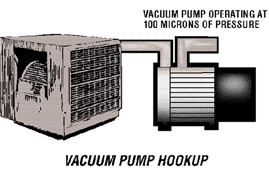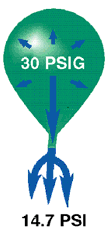Automotive tools & equipment
HVAC & Industrial supplies
Sales - parts -service
|
|
|
Factors Affecting The Speed At Which A Pump Can Dehydrate A Refrigerant System Last Updated: 09/28/2007 |
|||||||||||||||||||||||||||||||||||||||||||||||||||||||||||||||||||||||||||||||||||||||||||||||||||||||||||||||||||||||||||||||||||||||||||||||||
|
Several factors influence the "pumping speed" of a high vacuum pump, and thus the time required to remove all moisture from a refrigerant system. Some of the most important are: the cubic feet of the system; the amount of moisture contained within the system; the ambient temperature present; internal restrictions within the system; external restrictions between the system and the vacuum source; and the size of the pump. The only factors under the control of the service technician are the external restrictions between the system and the vacuum pump.
All of us have released an inflated balloon, allowing the escaping air pressure to propel it on a wild course. At other times you have inflated a balloon and stretched its stem, allowing the air to escape with a squealing sound. In effect, you were controlling the connecting I.D. as in the above illustration and, in turn, controlling the time it took to release all of its pressure. The principal is identical — the higher pressure is trying to move toward the lower pressure. These illustrations stress the importance of eliminating all external restrictions whenever possible. In answer to our first question, it is perfectly acceptable to use a 4 CFM or larger vacuum pump on a small system. Using too small of a pump on a large system, e.g. a 1.2 CFM vacuum pump on a 40 ton unit, could cause the pump to operate in a "free air" condition for an extended period of time, thus ri To answer our second question, the best way to know for sure that the system has been thoroughly dehydrated is by using a thermistor vacuum gauge. This prevents wasting time by pulling down after evacuation is complete or risking inadequate dehydration. When reading vacuum, remember that the location of the gauge tube will affect the reading. The closer the gauge is to the vacuum pump, the lower the reading will be. To get the most reliable reading, isolate the vacuum pump using a vacuum valve assembly. Let the pressure to equalize throughout the system, then take a final reading. Robinair offers a complete line of thermistor vacuum gauges. Our model 14010 indicates the vacuum level from 25,000 to 0 microns. Model 14830A shows vacuum level in 10 segments from 25,000 to 50 microns. The pocket-sized Model 14777 measures in ever smaller segments from 20,000 to 50 microns. To save service time, look for a thermistor vacuum gauge that fits the kind of service work you do and use it on a regular basis.
|
|||||||||||||||||||||||||||||||||||||||||||||||||||||||||||||||||||||||||||||||||||||||||||||||||||||||||||||||||||||||||||||||||||||||||||||||||
 Let us assume that all other variable factors affecting pump down time are equal within a system. Variable pressures within a system attempt to equalize one another. The higher pressure "flows" toward the lower pressure. The above illustration shows the variable pressure creating a vacuum of 100 microns and the system at higher atmospheric pressure. The higher pressure in the system will flow toward the vacuum pump until it is reduced or equal to the 100 microns of pressure. The speed at which it will flow is controlled by the I.D. and length of the connecting line. Laboratory tests show that pump down time can be significantly reduced by use of larger diameter hoses. For optimum pumping speed, keep access lines as short in length and as large in diameter as possible.
Let us assume that all other variable factors affecting pump down time are equal within a system. Variable pressures within a system attempt to equalize one another. The higher pressure "flows" toward the lower pressure. The above illustration shows the variable pressure creating a vacuum of 100 microns and the system at higher atmospheric pressure. The higher pressure in the system will flow toward the vacuum pump until it is reduced or equal to the 100 microns of pressure. The speed at which it will flow is controlled by the I.D. and length of the connecting line. Laboratory tests show that pump down time can be significantly reduced by use of larger diameter hoses. For optimum pumping speed, keep access lines as short in length and as large in diameter as possible.  sking premature pump wear.
sking premature pump wear.